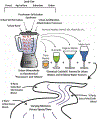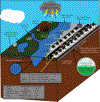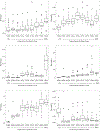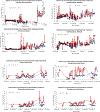Making 'Chemical Cocktails' - Evolution of Urban Geochemical Processes across the Periodic Table of Elements
- PMID: 33746355
- PMCID: PMC7970522
- DOI: 10.1016/j.apgeochem.2020.104632
Making 'Chemical Cocktails' - Evolution of Urban Geochemical Processes across the Periodic Table of Elements
Abstract
Urbanization contributes to the formation of novel elemental combinations and signatures in terrestrial and aquatic watersheds, also known as 'chemical cocktails.' The composition of chemical cocktails evolves across space and time due to: (1) elevated concentrations from anthropogenic sources, (2) accelerated weathering and corrosion of the built environment, (3) increased drainage density and intensification of urban water conveyance systems, and (4) enhanced rates of geochemical transformations due to changes in temperature, ionic strength, pH, and redox potentials. Characterizing chemical cocktails and underlying geochemical processes is necessary for: (1) tracking pollution sources using complex chemical mixtures instead of individual elements or compounds; (2) developing new strategies for co-managing groups of contaminants; (3) identifying proxies for predicting transport of chemical mixtures using continuous sensor data; and (4) determining whether interactive effects of chemical cocktails produce ecosystem-scale impacts greater than the sum of individual chemical stressors. First, we discuss some unique urban geochemical processes which form chemical cocktails, such as urban soil formation, human-accelerated weathering, urban acidification-alkalinization, and freshwater salinization syndrome. Second, we review and synthesize global patterns in concentrations of major ions, carbon and nutrients, and trace elements in urban streams across different world regions and make comparisons with reference conditions. In addition to our global analysis, we highlight examples from some watersheds in the Baltimore-Washington DC region, which show increased transport of major ions, trace metals, and nutrients across streams draining a well-defined land-use gradient. Urbanization increased the concentrations of multiple major and trace elements in streams draining human-dominated watersheds compared to reference conditions. Chemical cocktails of major and trace elements were formed over diurnal cycles coinciding with changes in streamflow, dissolved oxygen, pH, and other variables measured by high-frequency sensors. Some chemical cocktails of major and trace elements were also significantly related to specific conductance (p<0.05), which can be measured by sensors. Concentrations of major and trace elements increased, peaked, or decreased longitudinally along streams as watershed urbanization increased, which is consistent with distinct shifts in chemical mixtures upstream and downstream of other major cities in the world. Our global analysis of urban streams shows that concentrations of multiple elements along the Periodic Table significantly increase when compared with reference conditions. Furthermore, similar biogeochemical patterns and processes can be grouped among distinct mixtures of elements of major ions, dissolved organic matter, nutrients, and trace elements as chemical cocktails. Chemical cocktails form in urban waters over diurnal cycles, decades, and throughout drainage basins. We conclude our global review and synthesis by proposing strategies for monitoring and managing chemical cocktails using source control, ecosystem restoration, and green infrastructure. We discuss future research directions applying the watershed chemical cocktail approach to diagnose and manage environmental problems. Ultimately, a chemical cocktail approach targeting sources, transport, and transformations of different and distinct elemental combinations is necessary to more holistically monitor and manage the emerging impacts of chemical mixtures in the world's fresh waters.
Keywords: freshwater salinization syndrome; human-accelerated weathering; urban evolution; urban karst; urban watershed continuum.
Figures











References
-
- Abdelnour Alex, McKane Robert B., Marc Stieglitz, Feifei Pan, and Yiwei Cheng. 2013. “Effects of Harvest on Carbon and Nitrogen Dynamics in a Pacific Northwest Forest Catchment.” Water Resources Research 49 (3): 1292–1313. 10.1029/2012WR012994. - DOI
-
- Aitkenhead-Peterson JA, Steele MK, Nahar N, and Santhy K. 2009. “Dissolved Organic Carbon and Nitrogen in Urban and Rural Watersheds of South-Central Texas: Land Use and Land Management Influences.” Biogeochemistry 96 (1): 119–29. 10.1007/s10533-009-9348-2. - DOI
-
- Aitkenhead-Peterson Jacqueline A., Nahar Nurun, Harclerode Cara L., and Stanley Nina C.. 2011. “Effect of Urbanization on Surface Water Chemistry in South-Central Texas.” Urban Ecosystems 14 (2): 195–210. 10.1007/s11252-010-0147-2. - DOI
-
- Alexander Go B., Heston WM, and Iler RK. 1954. “The Solubility of Amorphous Silica in Water.” The Journal of Physical Chemistry 58 (6): 453–55. 10.1021/j150516a002. - DOI
-
- Appleyard S 1995. “The Impact Of Urban Development On Recharge And Groundwater Quality In A Coastal Aquifer Near Perth, Western Australia.” Hydrogeology Journal 3 (2): 65–75. 10.1007/s100400050072. - DOI
Grants and funding
LinkOut - more resources
Full Text Sources
